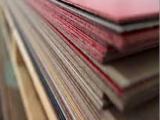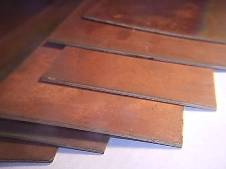Laminated electrical insulating plastics
 The most important of the layered electroinsulating plastics are: getinax, textolite and fiberglass. They consist of sheet fillers (paper, cloth) arranged in layers, and bakelite, epoxy, silicon silicon resins and their compositions are used as a binder.
The most important of the layered electroinsulating plastics are: getinax, textolite and fiberglass. They consist of sheet fillers (paper, cloth) arranged in layers, and bakelite, epoxy, silicon silicon resins and their compositions are used as a binder.
In order to increase the heat resistance of Bakelite resins, silicon-silicon substances are introduced into some of them, and epoxy resins are introduced into Bakelite and silicon-silicon resins to increase the adhesive ability. Special grades of impregnating paper (in getinax), cotton fabrics (in textolite) and alkali-free glass fabrics (in fiberglass) are used as fillers.
These fiber fillers are first impregnated with bakelite or silicon silicon varnishes (glass fabrics), dried and cut into sheets of certain sizes. The impregnated filler sheets are collected in bundles of predetermined thickness and hot pressed in multi-stage hydraulic presses.In the process of pressing, the individual layers of sheet fillers are firmly connected to each other with the help of resins, which turn into an insoluble and insoluble state.

The cheapest laminate is plastic laminated from wood (delta-wood)... It is obtained by hot pressing of thin (0.4-0.8 mm) sheets of birch veneer pre-impregnated with Bakelite resins.
The electrical characteristics of insulating delta wood grades are the same as the electrical characteristics of Getinax grade B, but delta wood has a heat resistance of 90 ° C, reduced splitting resistance and greater water absorption.
Delta-wood is used for the production of power structural and electrical insulating parts operating in oil (rods in oil switches, seals in oil-filled equipment, etc.). For outdoor use, delta wood products require careful protection from moisture with waterproof varnishes and enamels.
All laminated materials, except delta wood, can be used in the temperature range from -60 to + 105 ° C. Delta wood can be used at temperatures from -60 to + 90 ° C.
Asbestostextolite is a laminated electrical insulating plastic obtained by hot pressing sheets of asbestos fabric pre-impregnated with bakelite resin.Asbestostextolite is produced in the form of shaped products (spacers and wedges for rotors of turbine generators, small panels, etc.), as well as in the form of sheets and plates with a thickness of 6 to 60 mm. The mechanical and electrical strength of asbestos textolite is lower than that of getinax and textolite, but asbestos textolite has higher heat resistance. This material can be used at temperatures up to 155 °C (thermal class F).
Of the considered laminated electrical insulation materials, the highest heat resistance, better electrical characteristics, increased moisture resistance and resistance to fungi glass fiber laminate based on silicon and epoxy binders STK-41, STK-41 / EP, etc.P.
Some of the fiberglass ketoliths (STEF and STK-41 / EP) have increased mechanical strength comparable to the strength of textolites on cotton fabrics (classes A, B and D). These laminated materials, compared to getinax, have higher impact strength, significantly higher splitting resistance, not inferior to getinax in terms of tensile strength and static bending strength. Fiberglass laminates are difficult to machine because fiberglass is abrasive to steel tools.
